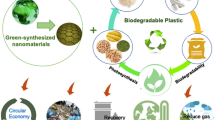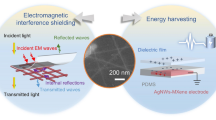Abstract
Silver nanoparticles with small particle size distribution and good dispersibility were synthesized through a facile chemical reduction method. In the progress, AgNO3 was used as the precursor, polyacrylic acid and ethanol amine were introduced as the protective agent, hydrazine hydrate was chosen as the reduce agent. Diameter of the resulted monodisperse silver nanoparticles is between 50 and 70 nm. Then, the obtained silver nanoparticles were well dispersed in the oil-based ink, which can be printed on a flexible polyimide substrate to form the conductive printed circuit board through following low temperature annealing treatment. A lowest electricity resistivity of 5.6 × 10−8 Ω m is obtained which is only 3.5× higher than that of bulk silver.










Similar content being viewed by others
References
D.Y. Wang, Y. Chang, Y.X. Wang, Q. Zhang, Z.G. Yang, Green water-based silver nanoplate conductive ink for flexible printed circuit. Mater. Technol. 31(1), 32–37 (2016)
Y.L. Tai, Y.X. Wang, Z.G. Yang, Z.Q. Chai, Green approach to prepare silver nanoink with potentially high conductivity for printed electronics. Surf. Interface Anal. 43(12), 1480–1485 (2011)
A. Kamyshny, S. Magdassi, Conductive nanomaterials for printed electronics. Small 10(17), 3515–3535 (2014)
X. Nie, H. Wang, J. Zou, Inkjet printing of silver citrate conductive ink on PET substrate. Appl. Surf. Sci. 261, 554–560 (2012)
P.C. Wang, C.P. Chang, M.J. Youh, Y.M. Liu, C.M. Chu, M.D. Ger, The preparation of pH-sensitive Pd catalyst ink for selective electroless deposition of copper on a flexible PET substrate. J. Taiwan Inst. Chem. Eng. 60, 555–563 (2016)
D.H. Shin, S. Woo, H. Yem, M. Cha, S. Cho, M. Kang, S. Jeong, Y. Kim, K. Kang, Y. Piao, A self-reducible and alcohol-soluble copper-based metal-organic decomposition ink fora printed electronics. ACS Appl. Mater. Interfaces 6(5), 3312–3319 (2014)
A. Ghosale, K. Shrivas, R. Shankar, V. Ganesan, Low cost paper electrode fabricated by direct writing with silver nanoparticles based ink for detection of hydrogen peroxide in waste water. Anal. Chem. 89, 776–782 (2017)
C.N. Chen, C.P. Chen, T.Y. Dong, T.C. Chang, M.C. Chen, H.T. Chen, Using nanoparticles as direct-injection printing ink to fabricate conductive silver features on a transparent flexible PET substrate at room temperature. Acta Mater. 60(16), 5914–5924 (2012)
R. Dharmadasa, M. Jha, D.A. Amos, T. Druffel, Room temperature synthesis of a copper ink for the intense pulsed light sintering of conductive copper films. ACS Appl. Mater. Interfaces 5(24), 13227–13234 (2013)
W. Li, W. Li, J. Wei, J. Tan, M. Chen, Preparation of conductive Cu patterns by directly writing using nano-Cu ink. Mater. Chem. Phys. 146(1), 82–87 (2014)
A.J. Kell, C. Paquet, O. Mozenson, I.D. Tabrizi, B. Deore, X. Liu, G.P. Lopinski, R. Jame, K. Hettak, J. Shaker, A. Momciu, J. Ferrigno, O. Ferrand, J.X. Hu, S. Lafrenière, P.R.L. Malenfant, Versatile molecular silver ink platform for printed flexible electronics. ACS Appl. Mater. Interfaces 9(20), 17226–17237 (2017)
J. Liang, K. Tong, Q. Pei, A water-based silver-nanowire screen-print ink for the fabrication of stretchable conductors and wearable thin-film transistors. Adv. Mater. 28(28), 5986–5996 (2016)
K. Ankireddy, M. Iskander, S. Vunnam, D.E. Anagnostou, J. Kellar, W. Cross, Thermal analysis of silver nanoparticles for flexible printed antenna fabrication. J. Appl. Phys. 114(12), 124303 (2013)
A. Kamyshny, M.B. Moshe, S. Aviezer, S. Magdassi, Ink-jet printing of metallic nanoparticles and microemulsions. Macromol. Rapid Commun. 26(4), 281–288 (2005)
Y. Zhang, P. Zhu, G. Li, T. Zhao, X. Fu, R. Sun, F. Zhou, C. Wong, Facile preparation of monodisperse, impurity-free, and antioxidation copper nanoparticles on a large scale for application in conductive ink. ACS Appl. Mater. Interfaces 6(1), 560–567 (2013)
L. Li, Y. Guo, X. Zhang, Y. Song, Inkjet-printed highly conductive transparent patterns with water based Ag-doped graphene. J. Mater. Chem. A 2(44), 19095–19101 (2014)
X.F. Tang, Z.G. Yang, W.J. Wang, A simple way of preparing high-concentration and high-purity nano copper colloid for conductive ink in inkjet printing technology. Colloids Surf. A 360(1), 99–104 (2010)
A. Russo, B.Y. Ahn, J.J. Adams, E.B. Duoss, J.T. Bernhard, J.A. Lewis, Pen-on-paper flexible electronics. Adv. Mater. 23(30), 3426–3430 (2011)
H. Qin, J. Dong, Y.S. Lee, AC-pulse modulated electrohydrodynamic jet printing and electroless copper deposition for conductive microscale patterning on flexible insulating substrates. Robot. Comput. Integr. Manuf. 43, 179–187 (2017)
R.R. Søndergaard, M. Hösel, F.C. Krebs, Roll-to-Roll fabrication of large area functional organic materials. J. Polym. Sci. B 51(1), 16–34 (2013)
B. Feng, X.L. Gu, X.B. Zhao, Y. Zhang, T.Y. Zhang, J.G. Shi, In situ synthesis of silver/chemically reduced graphene nanocomposite and its use for low temperature conductive paste. J. Mater. Sci.: Mater. Electron. 28(11), 7686–7691 (2017)
J. Luo, Z. Cheng, C. Li, L. Wang, C. Yu, Y. Zhao, M. Chen, Q. Li, Y. Yao, Electrically conductive adhesives based on thermoplastic polyurethane filled with silver flakes and carbon nanotubes. Compos. Sci. Technol. 129, 191–197 (2016)
C. Li, Q. Li, L. Cheng, T. Li, H. Lu, L. Tang, K. Zhang, S.E.J. Zhang, Z. Li, Y. Yao, Conductivity enhancement of polymer composites using high-temperature short-time treated silver fillers. Compos. A 100, 64–70 (2017)
C. Li, Q. Li, X. Long, T. Li, J. Zhao, K. Zhang, S.E.J. Zhang, Z. Li, Y. Yao, In situ generation of photosensitive silver halide for improving the conductivity of electrically conductive adhesives. ACS Appl. Mater. Interfaces 9, 29047–29054 (2017)
G. Wu, Y. Cheng, Z. Yang, Z.J.H. Wu, L. Yang, H. Li, P. Guo, H. Lv, Design of carbon sphere/magnetic quantum dots with tunable phase compositions and boost dielectric loss behavior. Chem. Eng. J. 333, 519–528 (2018)
G. Wu, Y. Cheng, K. Wang, Y. Wang, A. Feng, Fabrication and characterization of OMMt/BMI/CE composites with low dielectric properties and high thermal stability for electronic packaging. J. Mater. Sci.: Mater. Electron. 27(6), 5592–5599 (2016)
G. Wu, J. Li, K. Wang, Y. Wang, C. Pan, A. Feng, In situ synthesis and preparation of TiO2/polyimide composite containing phenolphthalein functional group. J. Mater. Sci.: Mater. Electron. 28, 6544–6551 (2017)
G. Wu, Y. Cheng, Z. Wang, K. Wang, A. Feng, In situ polymerization of modified graphene/polyimide composite with improved mechanical and thermal properties. J. Mater. Sci.: Mater. Electron. 28, 576–581 (2017)
C. Li, X. Gong, L. Tang, K. Zhang, J. Luo, L. Ling, J. Pu, T. Li, M. Li, Y. Yao, Electrical property enhancement of electrically conductive adhesives through Ag-coated-Cu surface treatment by terephthalaldehyde and iodine. J. Mater. Chem. C 3, 6178 (2015)
D. Deng, Y. Jin, Y. Cheng, T. Qi, F. Xiao, Copper nanoparticles: aqueous phase synthesis and conductive films fabrication at low sintering temperature. ACS Appl. Mater. Interfaces 5(9), 3839–3846 (2013)
F. Wang, H. Zhu, H. He, Low temperature sintering of Ag nanoparticles/graphene composites for paper based writing electronics. J. Phys. D 49(41), 415501 (2016)
K.Y. Shin, J.S. Lee, J.Y. Hong, J. Jang, One-step fabrication of a highly conductive and durable copper paste and its flexible dipole tag-antenna application. Chem. Commun. 50(23), 3093–3096 (2014)
X. Wu, S. Shao, Z. Chen, Z. Cui, Printed highly conductive Cu films with strong adhesion enabled by low-energy photonic sintering on low-Tg flexible plastic substrate. Nanotechnology 28(3), 035203 (2016)
W. Yang, C. Liu, Z. Zhang, Y. Liu, S. Nie, Preparation and conductive mechanism of copper nanoparticles ink. J. Mater. Sci.: Mater. Electron. 24(12), 5175–5182 (2013)
G.M. Durana, T.E. Benavidezb, J.G. Giulianic, A. Riosa, C.D. Garciab, Synthesis of CuNP-modified carbon eloectrodes obtained by pyrolysis of paper. Sens. Actuators B 227, 626–633 (2016)
T. Ramani, K.L. Prasanth, B. Sreedhar, Air stable colloidal copper nanoparticles: synthesis, characterization and their surface-enhanced Raman scattering properties. Physica E 77, 65–71 (2016)
H. Sim, J. Lee, T. Yu, K. Kim, S.J. Lee, J.H. Lee, J.H. Choc, B. Lim, Size-tunable and scalable synthesis of uniform copper nanocrystals. RSC Adv. 5(4), 2756–2761 (2015)
C.J. Wua, S.M. Chen, Y.J. Sheng, H.K. Tsao, Anti-oxidative copper nanoparticles and their conductive assembly sintered at room temperature. J. Taiwan Inst. Chem. Eng. 45(5), 2719–2724 (2014)
Y. Zhang, P. Zhu, L. Chen, G. Li, F. Zhou, D. Lu, R. Sun, F. Zhou, C. Wong, Hierarchical architectures of monodisperse porous Cu microspheres: synthesis, growth mechanism, high-efficiency and recyclable catalytic performance. J. Mater. Chem. A 2(30), 11966–11973 (2014)
Y. Zhang, P. Zhu, G. Li, W. Wang, L. Chen, D. Lu, R. Sun, F. Zhou, C. Wong, Highly stable and re-dispersible nano Cu hydrosols with sensitively size-dependent catalytic and antibacterial activities. Nanoscale 7(32), 13775–13783 (2015)
J. Wen, J. Li, S. Liu, Q. Chen, Preparation of copper nanoparticles in a water/oleic acid mixed solvent via two-step reduction method. Colloids Surf. A 373(1), 29–35 (2011)
Acknowledgements
The authors are grateful for the financial support from the National Natural Science Foundation of China (21571186), Guangdong Key Laboratory of High Density Electronic Packaging Key Materials (2014B030301014), Youth Innovation Promotion Association (2017411), Guangdong TeZhi plan youth talent of science and technology (2014TQ01C102), R&D Funds for basic Research Program of Shenzhen (JSGG20160229155249762).
Author information
Authors and Affiliations
Corresponding author
Rights and permissions
About this article
Cite this article
Shao, W., Li, G., Zhu, P. et al. Facile synthesis of low temperature sintering Ag nanopaticles for printed flexible electronics. J Mater Sci: Mater Electron 29, 4432–4440 (2018). https://doi.org/10.1007/s10854-017-8390-4
Received:
Accepted:
Published:
Issue Date:
DOI: https://doi.org/10.1007/s10854-017-8390-4




